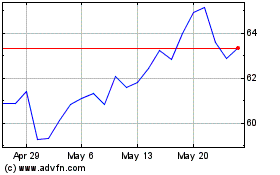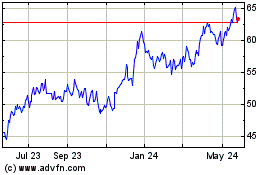The start of the New Year also led to the beginning of the much
awaited U.S. recovery. The economy started the period on a high
note and a solid first quarter performance is a testament to this
bullish trend (Top Performing ETFs of the First Quarter).
Indeed, the S&P 500 recorded strong gains in Q1 and remains
at elevated levels. S&P 500 registered a 10% rise in the first
three months of the year in spite of new worries in the euro-zone
debt crisis.
Panic initially spread in the market following the Cyprus issue
but with the distressed euro-zone member opening its banks,
tensions finally eased. This once again set the platform for
S&P 500 to push into record territory.
The strong momentum of the S&P 500 since the start of the
year indicates that the bull may be back in the market. A number of
sectors have performed remarkably well in the year-to-date period,
thanks to the market optimism (Four ETFs to Buy on the Market
Pullback).
In fact, many of the nine main sectors of the S&P 500 have
posted remarkable growth year to date, suggesting that the positive
sentiment is pretty widespread throughout the equity world.
However, one sector which remains impervious to the overall bullish
sentiment and strength in the market is the material sector.
XLB in focus
When almost all the SPDR exchange traded funds (ETFs) have
exhibited a strong performance in the year-to-date period,
Materials Select Sector SPDR Fund
(XLB) which has been
designed to tap the broad material sector has fallen far behind.
When SPDR S&P 500
(SPY) returned 9%, the
fund could just manage to provide investors with a gain of 1.62% in
the year-to-date period (5 Sector ETFs Surging to Start 2013).
The fund’s asset base of $2.8 billion is spread across holdings
of 32 securities. Monsanto is the largest holding in XLB,
accounting for 11.7% of the ETF. Other top holdings include Du Pont
de Nemours Co with 9.7% and Dow Chemical with 7.8%. The fund
appears to be quite popular as indicated by its trading volume of
more than 14 million shares a day.
The fund relies heavily on the chemical sector in which it has
assigned an asset base of 71.5%. Metals & mining also gets a
double-digit allocation of 16.56%. XLB charges a fee of 18 basis
points annually.
Behind the Slumping Materials ETF
It appears that the industrial metals sector continues to suffer
from unfavorable supply and demand conditions in 2013. Metal
producers are subject to cyclical fluctuations in prices, general
economic conditions and end-user markets. The tepid global economic
growth outlook has emerged as a major headwind for the global metal
industry (Time to Sell the Steel ETF?).
Moreover, cost inflation in the sector is expected to be a
headwind for metal and mining companies over the next several
years, driven by a number of factors, such as, labor, energy, ore
grades, currencies, supply constraints and taxes. Global economic
uncertainties, softening commodity prices and higher input costs
are increasing the pressure on company margins.
Also, growth in the emerging markets, particularly China and
India, was a major driver of metals demand over the last few years.
However, of late, demand in China has slowed down.
China's recent $150 billion infrastructure stimulus has helped
improve the sentiment somewhat and holds promise for the metals and
mining industry going forward.
Additionally, the U.S. coal industry may continue to face a
tough time in 2013 as well. Coal is facing tough competition from
natural gas. With enormous supply and comparatively lower prices
for U.S. natural gas, many utilities are preferring natural gas to
coal (Are Coal ETFs Back on Track?).
On the other hand, slumping gold prices have greatly impacted
the sector in 2013. With dollar and risky investments gaining
strength, gold which is regarded as a safe haven, has been losing
its shine. In fact, 2013 has seen a major fall in the prices of
gold.
This is evident from the year-to-date performance of gold ETFs.
SPDR Gold Shares
(GLD) has lost 6.97% so
far this year while the loss at iShares Gold Trust
(IAU) stands at
6.94%.
A Look at Other Material ETFs
It is just not XLB which has been exhibiting poor performance in
the material space. There are some others as well which have been
victims of the slowing material sector (The Guide to Broad Metals
and Mining ETFs).
In this context, SPDR S&P Metals and Mining ETF
(XME) turned out to be
the biggest disaster in the space with a year-to date loss of
16.73%. Another ETF which falls in the list is Market
Vectors Coal ETF (KOL) which lost about
12% over the same period.
Bottom Line
Thanks to this turmoil, we currently have a Zacks ETF Rank of 3
or ‘Hold’ on XLB, suggesting an in-line outlook over the next 12
months for the fund. So, we are looking for sluggish trading to
continue in this materials ETF, although with its low risk rating
we expect volatility levels to be rather small going
forward.
Want the latest recommendations from Zacks Investment Research?
Today, you can download 7 Best Stocks for the Next 30
Days. Click to get this free report >>
SPDR-GOLD TRUST (GLD): ETF Research Reports
ISHARS-GOLD TR (IAU): ETF Research Reports
SPDR-SP 500 TR (SPY): ETF Research Reports
SPDR-MATLS SELS (XLB): ETF Research Reports
SPDR-SP MET&MIN (XME): ETF Research Reports
To read this article on Zacks.com click here.
Zacks Investment Research
Want the latest recommendations from Zacks Investment Research?
Today, you can download 7 Best Stocks for the Next 30 Days. Click
to get this free report
SPDR S&P Metals and Mining (AMEX:XME)
Historical Stock Chart
From Dec 2024 to Jan 2025

SPDR S&P Metals and Mining (AMEX:XME)
Historical Stock Chart
From Jan 2024 to Jan 2025
